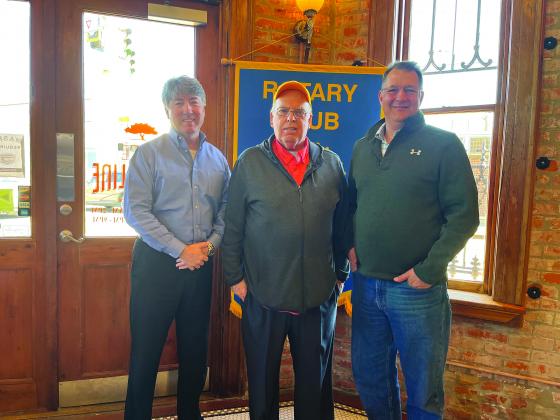Rotarian Dr. Philippe Vidrine invited retired biology professor Dr. Malcolm Vidrine to address the January 4, meeting of the Ville Platte Rotary Club.
Dr. Vidrine is a native of Mamou and graduated as valedictorian from Mamou High School in 1967. He recalled his first experience with Rotary was when he received a $125 scholarship from (Rotarian Judge) John Saunders. He earned a couple of degrees from LSU then went on to receive a doctorate in evolutionary ecology from USL.
Dr. Vidrine has worked on numerous conservation projects with different teams. They studied early American use of Louisiana mound villages to describe the landscapes. He noted over 100 years ago, the bayous ran clear and he is passionate about freshwater mussel conservation.
While in college, Dr. Vidrine wrote his dissertation on the effects of the mosquito population in rice fields and how to best control it.
In addition to his work with mussels, Dr. Vidrine is also passionate about prairie conservation. He has written numerous books and created models and habitats about the prairies of Southwest Louisiana. He stated there are “10 million reasons” to study the prairies, including wild flowers and other interesting plants, aesthetics, preservation, restoration and the study of underground carbon storage.
Dr. Vidrine enjoyed a career filled with many accomplishments, including authoring or co-authoring of 20 books and numerous scientific articles, the discovery of leprosy in wild armadillos, and important work with mussels at the Watson Brake archaeological site in northeast Louisiana. Dr. Vidrine’s role in the latter was to identify mussels in the Watson Brake middens, food commonly eaten by Native Americans.
“At Frenchman’s Bend and Watson Brake, the mussels must have been eaten raw,” Dr. Vidrine explained. “The shells were intact and easy to identify — many of them appear very similar to shells found on the banks of streams today. I was able to generate good inventories of species and their compositions in the middens, which allowed me to make some general observations about the streams from which the mussels were collected. These findings combined with information from other members of the team made their way into two major publications, one in ‘Science’ and the other in ‘American Antiquity.’” Dr. Vidrine’s findings helped date Watson Brake to 3,500–2,800 BCE, one of the oldest in the country.
Dr. Vidrine insists much of his research and accomplishments have been part of a team, including creating the Cajun Prairie Restoration Project in Eunice with Charles Allen. The two had been searching for surviving prairie remnants in Southwest Louisiana in the late 1980s and found a prime spot on a railroad right-of-way.
“I was impressed by the variety of flowering plants in the July sun on that fortunate afternoon,” Vidrine remembered. “I told Charles that I had seen many stretches of such plants in Jefferson Davis Parish when I worked as the research director and mosquito biologist there. The next week we were driving around and searching for prairie remnants along railroads throughout the region. We found many of them, but only a few were of any significant size. The next five summers were spent inventorying the plants, butterflies and dragonflies of the prairie remnants. These searches culminated in papers, books and restoration projects.”
The two convinced then Eunice Mayor Curtis Joubert to lease a piece of railroad property as a city park and the Cajun Prairie Restoration Project was born. Today, visitors may walk through native plants within its 10 acres, currently owned by the Cajun Prairie Habitat Preservation Society.
Dr. Vidrine continues the restoration work on three acres outside his Eunice home, a stretch of prairie called the Cajun Prairie Gardens. He and his wife, Gail, have published articles and books on their restoration efforts, plus they host groups to introduce others to a Louisiana environment they helped preserve and hope to propagate.
Also during the meeting, Secretary Renee Brown announced a tour of the State Capital in Baton Rouge, followed by lunch at the Pentagon Barracks, will be held Wednesday, April 6, 2022. The tour will begin at 10 a.m., and lunch will follow. Representative Rhonda Butler will host the tour, which is open to members of the Evangeline Parish and St. Landry Parish chambers of commerce, as well as members of the Ville Platte Rotary Club. Brown stated the deadline to register and RSVP via email is March 30, and more information about the visit will be forthcoming.
The next meeting will be held January 11, 2022, with Rotarian Wayne Vidrine presenting the program.
- Log in to post comments

